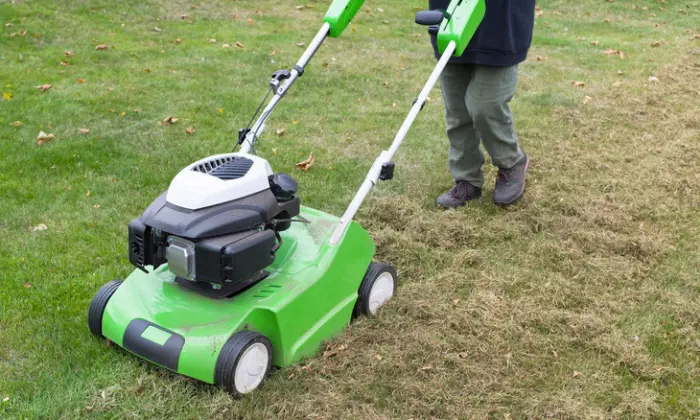- (562) 208-0148
- robertscompletecare@hotmail.com
Lawn Dethatcher Rental Revitalize Your Law
Maintaining a lush and healthy lawn requires regular care and attention. One essential aspect of lawn care is dethatching, which involves removing the layer of dead grass and debris that accumulates on the soil surface. Lawn dethatching helps improve air circulation, water absorption, and nutrient penetration into the soil, resulting in a greener and more vibrant lawn. If you’re a homeowner or a gardening enthusiast in the La Habra Heights, CA, area looking to revitalise your lawn, lawn dethatcher rental is a convenient and cost-effective solution.

What is Lawn Dethatching?
Lawn dethatching, also known as scarifying or vertical mowing, is the process of mechanically removing the excessive thatch layer from your lawn. This can be done using a specialized machine called a dethatcher or a vertical mower. The equipment typically features rotating blades or tines that penetrate the thatch layer, loosening it and bringing it to the surface. Once the thatch is loosened, it can be easily collected and removed from the lawn.
Understanding the Importance of Dethatching
What is Lawn Thatch?
Before delving into the benefits of dethatching, it’s essential to understand what lawn thatch is. Thatch is a layer of organic matter that builds up on the soil surface, consisting of dead grass, roots, and other debris. While a thin layer of thatch can be beneficial, excessive thatch can suffocate the grass and hinder proper growth.
The Need for Lawn Dethatching
As the thatch layer thickens, it can create a barrier that prevents water, air, and nutrients from reaching the grass’s root zone. This can lead to shallow root growth, increased susceptibility to diseases, and reduced tolerance to environmental stress. Lawn dethatching helps address these issues, promoting healthier and stronger grass growth.
Best Practices for Lawn Care
Combining Dethatching with Other Lawn Maintenance:
When dethatching your lawn, it’s beneficial to combine it with other lawn maintenance practices to achieve optimal results. Some essential tasks to incorporate are:
Aeration:
Aerating your lawn helps alleviate soil compaction and improves air, water, and nutrient penetration to the grassroots. Performing aeration before or after dethatching can enhance the overall health of your lawn.
Overseeding:
After dethatching and aerating, consider overseeding your lawn with suitable grass seed varieties. This will help fill in thin areas and promote a denser, healthier turf.
Fertilization and Watering Tips:
Proper fertilization and watering play a crucial role in maintaining a lush and green lawn:
Fertilization:
Use a balanced and appropriate fertilizer based on your lawn’s grass type and specific needs. Follow the recommended application rates and schedule, typically in the spring and fall, to provide essential nutrients for healthy growth.
Watering:
Water your lawn deeply and infrequently rather than frequent shallow watering. This encourages deep root growth and makes the grass more drought-resistant. Water early in the morning to reduce evaporation and minimize the risk of fungal diseases.
Aeration’s Role in Lawn Health
Aeration is an essential practice that enhances the overall health of your lawn:
Reducing soil compaction:
Compacted soil restricts root growth and prevents the efficient uptake of nutrients and water. Aeration loosens the soil, promoting better root development.
Enhancing nutrient absorption:
A well-aerated lawn allows nutrients to penetrate the soil and reach the grassroots, supporting healthy plant growth.
Improving water drainage:
Aeration helps prevent waterlogged areas by creating channels for excess water to drain away, reducing the risk of standing water and related issues.
Mowing Practices:
Proper mowing is essential for maintaining a healthy lawn:
Set the mower height correctly:
Adjust your mower to the recommended height for your grass species. Mowing too short can stress the grass and promote weed growth, while mowing too tall can lead to thatch buildup and make the lawn more susceptible to disease.
Regular mowing:
Mow the lawn regularly, especially during the growing season, to maintain an even height and prevent the grass from becoming overgrown.
Mulch the clippings:
Instead of bagging grass clippings, consider mulching them back into the lawn. This returns valuable nutrients to the soil and reduces waste.
Weed and Pest Control:
Controlling weeds and pests is essential to maintaining a beautiful and healthy lawn:
Weed management:
Regularly inspect your lawn for weeds and promptly address any emerging issues. Use appropriate herbicides or opt for natural weed control methods.
Pest prevention:
Keep an eye out for signs of pests and take preventive measures, such as using pest-resistant grass varieties and promoting a healthy lawn through proper care.
By following these best practices, you can establish a strong foundation for a vibrant and flourishing lawn. Regularly assessing the condition of your lawn and adjusting your maintenance practices accordingly will help ensure long-term success in lawn care.
The Benefits of Lawn Dethatcher Rental
Cost-Effectiveness
Owning a lawn dethatcher might not be practical for every homeowner, especially if dethatching is needed infrequently. Renting a lawn dethatcher from a reliable provider like Robert Complete Care allows you to access the equipment you need without breaking the bank.
Convenience and Flexibility
Lawn dethatcher rental offers convenience and flexibility, as you can easily schedule the rental based on your lawn’s specific needs. It allows you to plan your lawn care routine effectively and dethatch when it’s most suitable for the grass’s growth cycle.
Quality Equipment
Reputable lawn care equipment rental services offer well-maintained and high-quality dethatchers. Using professional-grade equipment ensures efficient dethatching, resulting in better outcomes for your lawn.
Expert Guidance
Rental providers often have knowledgeable staff who can guide you on the proper usage of the dethatcher. They can provide essential tips and recommendations for achieving the best results.
Renting a Lawn Dethatcher
Researching Local Rental Providers
When seeking a lawn dethatcher rental service, it’s crucial to research and compare various local providers. Look for reviews and testimonials from previous customers to ensure you’re choosing a reputable company.
Checking Equipment Availability
Before finalizing your rental, confirm that the lawn dethatcher you need is available on your preferred date. Consider making a reservation in advance during peak lawn care seasons.
Understanding Rental Terms
Read and understand the rental agreement thoroughly. Pay attention to factors like rental duration, pricing, and any additional fees that may apply.
Environmentally Friendly Dethatching
When it comes to maintaining a healthy and green lawn, dethatching is an essential process to remove the buildup of dead grass, roots, and other organic debris that can hinder proper growth. Traditional dethatching methods may involve the use of gas-powered machines and chemical-based products, but there are several environmentally friendly and sustainable alternatives you can consider:
Manual Dethatching:
Instead of using gas-powered dethatching machines, consider using hand tools like a thatching rake or a dethatching comb. These tools are effective in removing thatch without relying on fossil fuels or electricity.
Mulch Mowing:
This technique involves using a special mower that chops grass clippings into fine pieces, which then get deposited back into the lawn. These clippings act as natural mulch, providing nutrients to the soil and reducing thatch buildup over time.
Compost Topdressing:
Apply a thin layer of compost over your lawn, which can help break down thatch naturally while also improving soil health. Compost provides essential nutrients to the grass and encourages beneficial microbial activity in the soil.
Aeration:
Aerating your lawn helps create channels in the soil, allowing air, water, and nutrients to penetrate deeper into the roots. This can improve the overall health of your lawn and reduce thatch accumulation.
Overseeding:
Regularly overseed your lawn with grass varieties that are well-suited to your climate and soil conditions. Dense, healthy grass can help prevent excessive thatch buildup.
Avoid Overwatering:
Excessive watering can contribute to thatch accumulation. Instead, water deeply but infrequently to encourage deeper root growth and discourage thatch formation.
Use Organic Fertilizers:
When fertilizing your lawn, opt for organic, slow-release fertilizers. These fertilizers release nutrients gradually, promoting healthier grass growth and reducing thatch buildup compared to synthetic fertilizers.
Implement Proper Lawn Maintenance:
Regularly mow your lawn at the recommended height for your grass type and avoid cutting more than one-third of the grass blade length at a time. This practice helps maintain a strong root system and minimizes thatch formation.
Monitor Soil pH:
Ensure your lawn’s soil pH is within the appropriate range for your grass type. Soil that is too acidic or alkaline can contribute to thatch problems and hinder nutrient uptake by the grass.
Troubleshooting Common Dethatching Issues
Addressing Scalping and Bare Spots:
Scalping occurs when the dethatching machine cuts too deeply into the grass, removing not only the thatch but also the healthy grass blades. This can lead to bare spots and uneven lawn appearance.
Adjust the dethatcher height:
Set the dethatcher blades or tines to a shallower depth. This will prevent it from cutting into the healthy grass and minimize the risk of scalping.
Overseed bare spots:
After dethatching, overseed the bare areas to encourage new grass growth and fill in the gaps.
Water and fertilize:
Keep the newly seeded areas adequately watered and fertilized to promote healthy germination and establishment of new grass.
Dealing with Thatch Build-Up:
If your lawn has excessive thatch build-up and the dethatcher struggles to remove it effectively, you can take the following steps:
Pre-mow the lawn:
Before dethatching, give your lawn a close cut with a lawnmower to reduce the thatch layer’s thickness. This will make it easier for the dethatcher to penetrate and remove the thatch.
Dethatch in different directions:
If the thatch layer is particularly thick and stubborn, dethatch the lawn in multiple directions. This cross-pattern approach can help break up the thatch more effectively.
Aerate the lawn:
After dethatching, consider aerating the lawn to improve soil compaction and enhance nutrient and water penetration.
Fixing Uneven Dethatching Results:
Uneven dethatching results can occur due to various reasons, such as operator error or uneven lawn terrain.
Maintain a consistent speed:
When using a dethatching machine, try to maintain a steady and consistnt speed throughout the process. Avoid speeding up or slowing down abruptly, as it can lead to uneven results.
Overlap each pass:
If using a walk-behind dethatcher, overlap each pass slightly to ensure complete coverage and prevent missed areas.
Adjust blade or tine spacing:
Some dethatchers allow you to adjust the spacing between blades or tines. Experiment with different settings to find the one that provides the most even results for your lawn.
Overall, troubleshooting dethatching issues involves careful adjustments and considerations to achieve the best results. Remember to take preventive measures and perform regular lawn maintenance to minimize thatch buildup and keep your lawn looking healthy and well-maintained. If you encounter persistent problems, consider seeking advice from lawn care professionals or equipment specialists.
Lawn Dethatching: DIY or Professional Service
DIY Dethatching
If you decide to dethatch your lawn yourself, make sure you follow proper techniques and guidelines. Avoid excessive dethatching, as it can damage the grass and disrupt the soil.
Hiring Professional Lawn Care Services
Alternatively, you can opt for professional lawn care services that offer dethatching as part of their package. Professional lawn care providers have the expertise and equipment to perform the task efficiently and effectively. Robert complete care also provide Hauling and Junk removal services
Residential lawn mowing services
At Robert Complete Care, we take pride in offering top-notch residential lawn mowing services to enhance the beauty and vitality of your outdoor space. Our team of dedicated professionals understands the importance of a well-maintained lawn, and we’re committed to providing meticulous care that transforms your yard into a lush and inviting oasis.
Conclusion
Lawn dethatching is a vital aspect of maintaining a healthy and thriving lawn. Renting a lawn dethatcher from a trusted provider like Robert Complete Care in the La Habra Heights, CA, area can be a smart and convenient choice for homeowners. By dethatching your lawn, you can ensure that your grass receives the nutrients and care it needs to flourish throughout the year. Please feel free to contact us for any inquiries or assistance you may need.
FAQs
It’s recommended to dethatch your lawn when the thatch layer exceeds half an inch in thickness, typically every 1 to 3 years.
It’s best to detatch your lawn during the growing season, either in early spring or early fall, when the grass is actively growing.
No, dethatching and aerating are different processes. Dethatching involves removing the layer of thatch, while aerating focuses on creating holes in the soil to improve air circulation and water absorption.
Yes, overseeding your lawn after dethatching can help fill in bare spots and promote thicker, healthier grass growth.
It’s advisable to remove the dethatched material from the lawn to prevent it from smothering the grass. Raking or bagging the thatch is recommended after dethatching.

